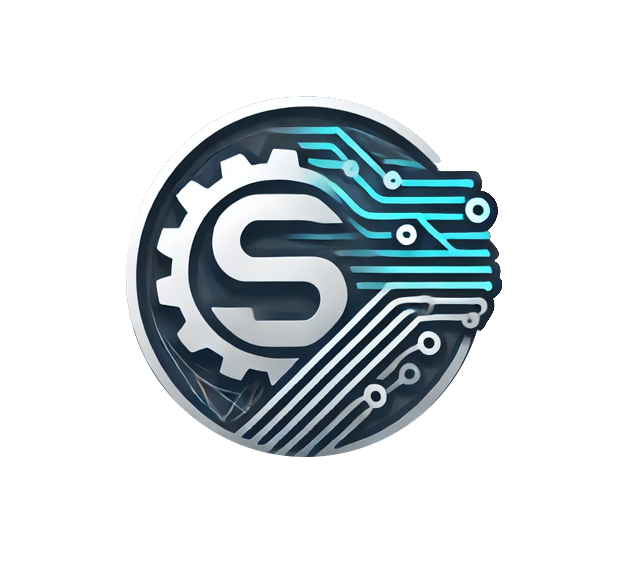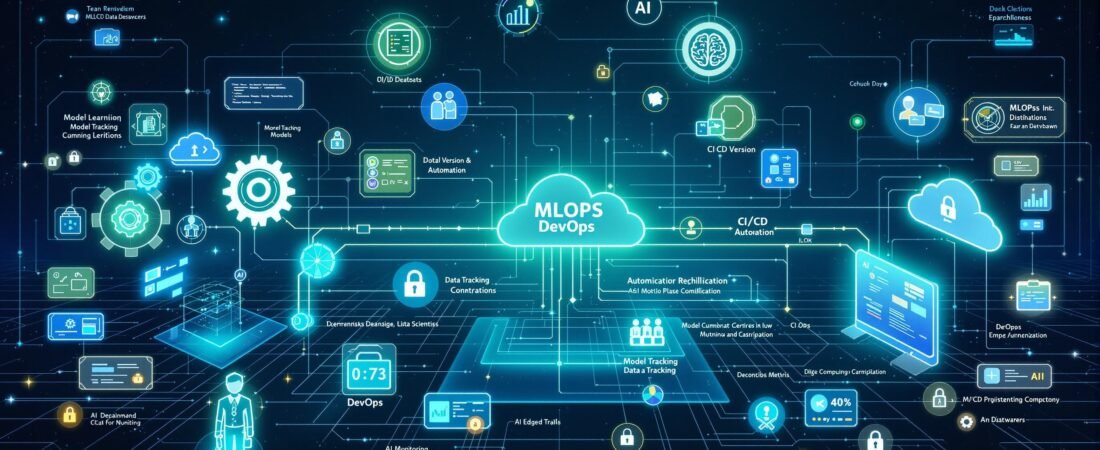Introduction: Why Integrate MLOps and DevOps?
In today’s technology landscape, the boundaries between software engineering and machine learning are becoming increasingly blurred. As organizations strive to deliver intelligent applications at scale, the integration of MLOps (Machine Learning Operations) and DevOps (Development Operations) has emerged as a critical success factor. While DevOps has revolutionized the way software is built, tested, and deployed, MLOps extends these principles to the unique challenges of machine learning workflows.
Integrating MLOps and DevOps enables teams to streamline the end-to-end lifecycle of machine learning models—from data preparation and experimentation to deployment and monitoring in production. This integration ensures that models are not only developed efficiently but also maintained, updated, and governed with the same rigor as traditional software. By bridging the gap between data science and engineering, organizations can accelerate innovation, reduce operational risks, and deliver more reliable AI-powered solutions to end users.
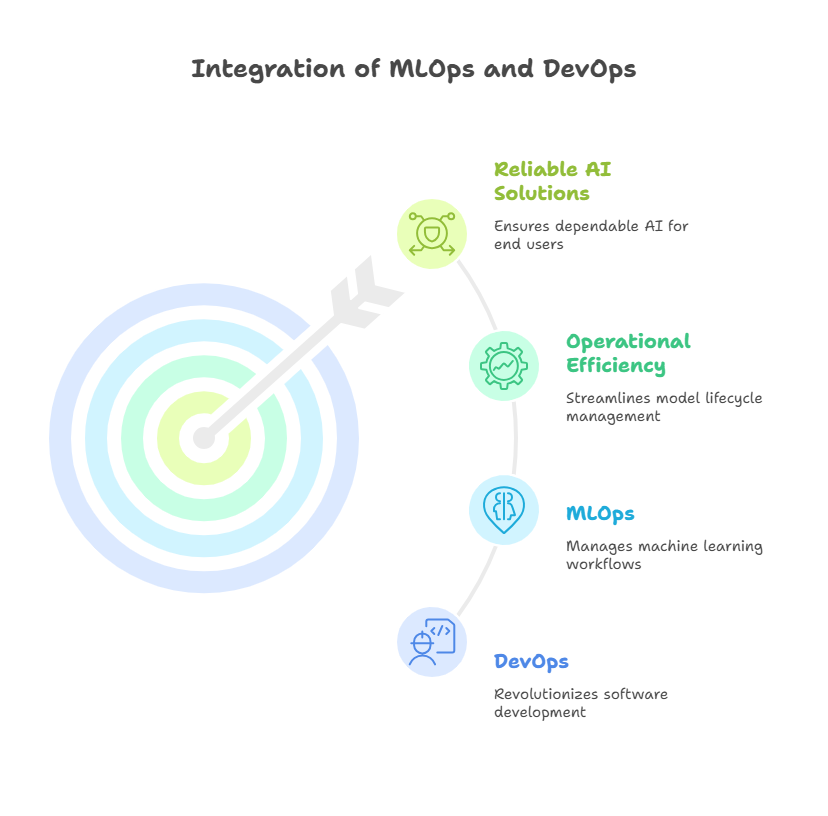
Key Differences and Similarities Between MLOps and DevOps
Although MLOps and DevOps share a common goal of automating and optimizing the delivery of technology solutions, they address different challenges and require distinct approaches. DevOps focuses on the continuous integration, delivery, and monitoring of software applications. It emphasizes practices such as version control, automated testing, infrastructure as code, and rapid deployment cycles.
MLOps, on the other hand, builds upon these foundations but introduces additional complexities unique to machine learning. Unlike traditional software, ML projects involve not only code but also data, model artifacts, and experimentation results. Managing data versioning, model reproducibility, and performance monitoring are central to MLOps. Moreover, ML models can degrade over time due to data drift, requiring ongoing retraining and validation.
Despite these differences, both MLOps and DevOps prioritize automation, collaboration, and feedback loops. They encourage breaking down silos between teams, fostering a culture of shared responsibility, and leveraging tools that support reproducibility and scalability. By recognizing both the overlaps and distinctions, organizations can design integrated workflows that harness the strengths of each discipline, ultimately leading to more robust and agile AI systems.
The Benefits of Unified Workflows
Integrating MLOps and DevOps into a unified workflow brings significant advantages to organizations aiming to deliver machine learning solutions at scale. One of the primary benefits is increased efficiency—by standardizing processes and automating repetitive tasks, teams can reduce manual effort and accelerate the journey from experimentation to production. Unified workflows also enhance consistency and reliability, as both code and models are subject to the same rigorous testing, versioning, and deployment standards.
Another key advantage is improved collaboration. When data scientists, machine learning engineers, and software developers work within a shared framework, communication barriers are minimized. This leads to faster problem-solving, better alignment on project goals, and a smoother handoff between research and production teams. Additionally, unified workflows make it easier to track changes, audit model performance, and ensure compliance with organizational and regulatory requirements. Ultimately, this integration supports the delivery of robust, scalable, and maintainable AI systems that can adapt to changing business needs.
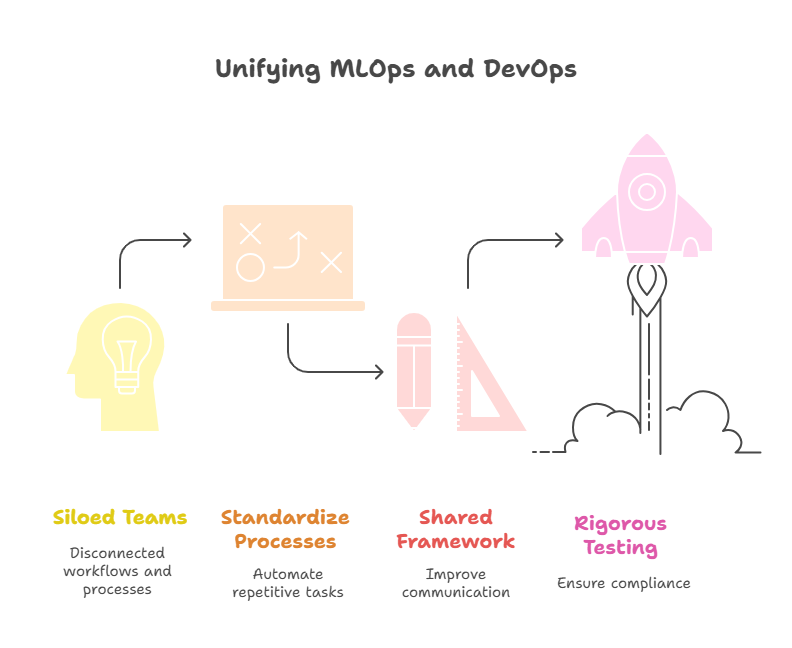
Building a Collaborative Culture: Developers, Data Scientists, and Operations
A successful integration of MLOps and DevOps is not just about tools and processes—it also requires a collaborative culture that brings together developers, data scientists, and operations teams. Traditionally, these groups have operated in silos, each with their own priorities and workflows. Developers focus on building and maintaining software, data scientists on experimentation and model development, and operations teams on deployment and system reliability.
To break down these barriers, organizations need to foster a culture of shared responsibility and open communication. This can be achieved by encouraging cross-functional teams, regular knowledge sharing sessions, and joint ownership of the entire machine learning lifecycle. Adopting common tools and platforms also helps, as it provides a shared language and set of practices for all stakeholders. When everyone is aligned around the same objectives and understands the challenges faced by other teams, it becomes much easier to deliver high-quality, production-ready AI solutions. This collaborative approach not only accelerates innovation but also ensures that machine learning initiatives are sustainable and impactful in the long term.
Tools and Platforms Supporting Integration
The integration of MLOps and DevOps is greatly facilitated by a growing ecosystem of tools and platforms designed to bridge the gap between software engineering and machine learning. These solutions provide end-to-end support for the entire machine learning lifecycle, from data ingestion and preprocessing to model training, deployment, and monitoring. Popular platforms such as MLflow, Kubeflow, and TensorFlow Extended (TFX) offer modular components that can be integrated with existing DevOps pipelines, enabling seamless collaboration between data science and engineering teams.
Cloud providers like AWS, Azure, and Google Cloud have also introduced comprehensive MLOps services—such as SageMaker, Azure Machine Learning, and Vertex AI—that natively support DevOps practices like CI/CD, infrastructure as code, and automated monitoring. These platforms often include built-in tools for version control, experiment tracking, and model registry, making it easier to manage the complexity of machine learning projects. Additionally, containerization technologies like Docker and orchestration tools like Kubernetes play a crucial role in standardizing environments and ensuring reproducibility across development and production. By leveraging these tools, organizations can create robust, scalable, and maintainable workflows that support both rapid experimentation and reliable deployment.
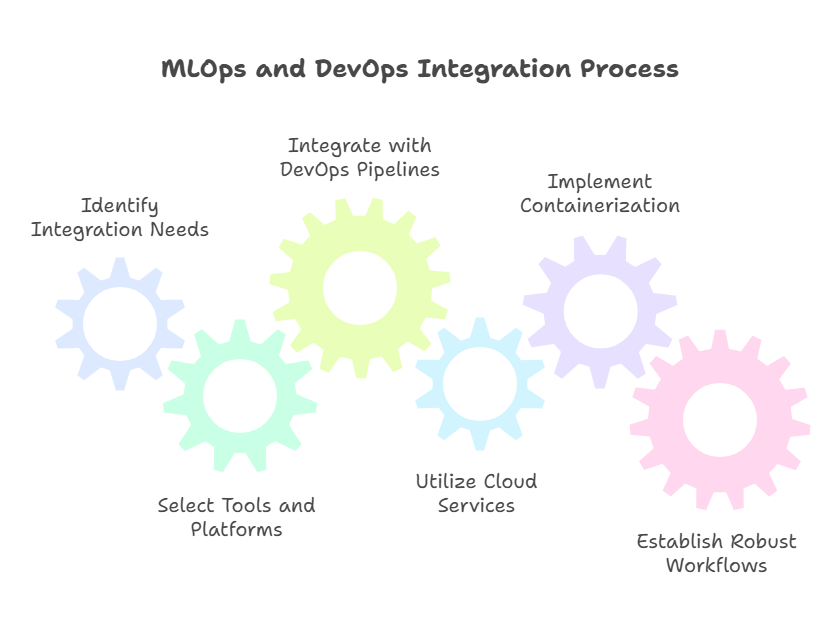
Automating the Machine Learning Lifecycle with DevOps Principles
Applying DevOps principles to the machine learning lifecycle is essential for achieving automation, scalability, and reliability in AI projects. Automation begins with data ingestion and preprocessing, where pipelines can be set up to automatically collect, clean, and transform data as it becomes available. This ensures that models are always trained on the most up-to-date and relevant information. Automated testing frameworks can validate not only code but also data quality and model performance, catching issues early in the development process.
Continuous integration and continuous delivery (CI/CD) pipelines, a hallmark of DevOps, are adapted in MLOps to handle the unique requirements of machine learning. These pipelines automate the process of training, validating, and deploying models, reducing manual intervention and the risk of human error. Infrastructure as code allows teams to define and manage resources programmatically, ensuring consistency across environments. Monitoring and feedback loops are also automated, enabling rapid detection of model drift or performance degradation and triggering retraining or rollback as needed. By embracing these DevOps-inspired practices, organizations can streamline the machine learning lifecycle, accelerate time to value, and maintain high standards of quality and reliability in their AI solutions.
Version Control for Code, Data, and Models
Why it matters
Machine-learning projects evolve along three axes—code, data, and models. Failing to version any one of them breaks reproducibility and makes rollbacks nearly impossible. A robust version-control strategy guarantees that every experiment can be traced, audited, and reproduced end-to-end.
Core tooling
• Code – Git (plus branching, pull requests, tags, semantic commits)
• Data – DVC, LakeFS, Pachyderm, or Delta Lake time-travel
• Models – MLflow Model Registry, Weights & Biases Artifacts, or Neptune.ai
• Metadata glue – committing a params.yaml (hyper-parameters), experiment IDs, and dataset hashes alongside the code
Practical workflow
Data scientist creates a new Git branch: feature/churn-experiment-v3.
Raw dataset is stored in object storage; a DVC pointer file (.dvc) is checked into Git.
Training code produces model.pkl; dvc add models/model.pkl attaches it to the same commit.
Results are logged to MLflow; the experiment run stores the Git SHA and DVC data revision for perfect traceability.
A pull request merges the branch; CI verifies that the metadata and checksums match.
Example Python snippet
Below, the project reads exactly the dataset and model that belong to Git tag v1.2, ensuring bit-for-bit reproducibility:
python
# requirements: dvc[s3], mlflow, pandas
import dvc.api
import pandas as pd
import mlflow.pyfunc
from mlflow.tracking import MlflowClient
# 1️⃣ Resolve the dataset URL as it existed in tag v1.2
data_url = dvc.api.get_url(
path="data/processed/train.csv",
rev="v1.2" # Git tag / SHA
)
df = pd.read_csv(data_url)
# 2️⃣ Load the registered model that was promoted alongside v1.2
client = MlflowClient()
model_uri = "models:/churn_model/Production"
model = mlflow.pyfunc.load_model(model_uri)
# 3️⃣ Make predictions with the right data–model pair
preds = model.predict(df)
print(preds[:5])The commit history now forms a complete lineage graph linking code, data, and model artifacts—crucial for audits and debugging.
8. CI/CD Pipelines for Machine-Learning Projects
From DevOps to MLOps CI/CD
Traditional CI/CD automates build → test → deploy for software. In MLOps we extend the pipeline:
Build
• create reproducible training environment (Docker, conda)
• fetch the pinned dataset revision (DVC pull)
Test
• unit tests for code
• data-quality checks (Great Expectations, pandera)
• model-performance gate (must exceed threshold)
Package & Upload
• push model artifact to registry
• generate Docker image / serverless bundle
Deploy & Monitor
• rolling update or canary release
• register monitoring hooks (latency, drift)
Reference directory layout
.
├── data/ # DVC-tracked
├── models/
├── src/
│ ├── train.py
│ └── inference.py
├── tests/
│ └── test_performance.py
├── params.yaml
└── .github/workflows/ml_ci_cd.yml
Key Python scripts used in the pipeline
src/train.py – runs during the build stage and logs artifacts:
python
# requirements: scikit-learn, joblib, mlflow, pandas, yaml
import yaml, joblib, mlflow, pandas as pd
from sklearn.ensemble import RandomForestClassifier
from sklearn.metrics import f1_score
def load_params():
with open("params.yaml") as f:
return yaml.safe_load(f)
def main():
p = load_params()
df = pd.read_csv("data/processed/train.csv")
X, y = df.drop("target", axis=1), df["target"]
model = RandomForestClassifier(
n_estimators=p["n_estimators"],
max_depth=p["max_depth"],
random_state=42
).fit(X, y)
joblib.dump(model, "models/random_forest.joblib")
mlflow.log_params(p)
mlflow.sklearn.log_model(model, artifact_path="model")
mlflow.log_metric("f1_train", f1_score(y, model.predict(X)))
if __name__ == "__main__":
main()tests/test_performance.py – executed in test stage; fails the pipeline if the new model under-performs:
python
# run with: pytest -q
import joblib, pandas as pd
from sklearn.metrics import f1_score
THRESHOLD = 0.75 # CI performance gate
def test_model_quality():
model = joblib.load("models/random_forest.joblib")
df = pd.read_csv("data/processed/validation.csv")
X_val, y_val = df.drop("target", axis=1), df["target"]
f1 = f1_score(y_val, model.predict(X_val))
assert f1 >= THRESHOLD, f"F1={f1:.3f} fell below {THRESHOLD}"Putting it together with GitHub Actions
The YAML below (stored in .github/workflows/ml_ci_cd.yml) wires the pieces; every push triggers training, testing, and—on the main branch—deployment:
yaml
name: ml-ci-cd
on:
push:
branches: [main, feature/*]
jobs:
build-test-deploy:
runs-on: ubuntu-latest
steps:
- uses: actions/checkout@v4
- name: Set up Python
uses: actions/setup-python@v5
with:
python-version: "3.11"
- name: Install dependencies
run: |
pip install -r requirements.txt
pip install dvc[s3] mlflow
- name: Pull data (DVC)
run: dvc pull -q
- name: Train model
run: python src/train.py
- name: Run tests
run: pytest -q
- name: Deploy model (only on main)
if: github.ref == 'refs/heads/main'
run: |
mlflow models serve -m models/random_forest.joblib &With code, data, and model artifacts all versioned and validated automatically, the team gains a repeatable, auditable, and fast pathway from commit to production—realizing the full promise of integrating MLOps with DevOps.
Monitoring, Logging, and Feedback Loops
Effective monitoring and logging are essential for maintaining the health and performance of machine learning systems in production. Unlike traditional software, ML models can degrade over time due to changes in data distributions, known as data drift or concept drift. Continuous monitoring allows teams to detect these issues early, ensuring that models remain accurate and reliable.
Modern MLOps platforms provide built-in tools for tracking key metrics such as prediction accuracy, latency, throughput, and resource usage. Logging frameworks capture detailed information about model inputs, outputs, and system events, which is invaluable for debugging and auditing. Feedback loops are established by collecting real-world outcomes and comparing them to model predictions, enabling teams to identify when retraining or model updates are necessary.
A robust monitoring setup not only helps in detecting performance drops but also supports compliance and transparency requirements. Automated alerts can notify teams of anomalies, while dashboards provide real-time visibility into model behavior. By integrating monitoring and logging into the MLOps pipeline, organizations can respond quickly to issues, minimize downtime, and continuously improve their AI solutions.
Security and Compliance in Integrated Pipelines
As machine learning systems become more deeply integrated into business processes, ensuring security and compliance throughout the MLOps and DevOps pipeline is increasingly important. Security in this context means protecting sensitive data, safeguarding model intellectual property, and preventing unauthorized access to both code and deployed models.
Best practices include encrypting data at rest and in transit, implementing strict access controls, and regularly auditing logs for suspicious activity. Containerization and infrastructure as code help standardize environments and reduce the risk of configuration drift, while automated vulnerability scanning tools can identify and mitigate security risks early in the development cycle.
Compliance is another critical aspect, especially in regulated industries such as finance, healthcare, and government. Integrated pipelines should support traceability by versioning all artifacts—code, data, and models—and maintaining detailed audit trails. Documentation and automated reporting can help demonstrate adherence to legal and ethical standards, such as GDPR or HIPAA.
By embedding security and compliance checks into every stage of the pipeline, organizations not only protect themselves from threats and regulatory penalties but also build trust with users and stakeholders. This proactive approach ensures that machine learning solutions are not only innovative and effective but also safe, ethical, and reliable.
Common Challenges and How to Overcome Them
Integrating MLOps and DevOps brings many benefits, but it also introduces a unique set of challenges that organizations must address to achieve smooth and effective workflows. One of the most common obstacles is the cultural divide between data science and engineering teams. Data scientists often prioritize experimentation and rapid iteration, while DevOps and engineering teams focus on stability, reproducibility, and operational efficiency. Bridging this gap requires fostering a culture of collaboration, shared responsibility, and open communication, where both groups understand each other’s priorities and constraints.
Another challenge is managing the complexity of versioning not just code, but also data and models. Unlike traditional software, machine learning projects are highly sensitive to changes in data, and even small variations can lead to significant differences in model performance. Implementing robust version control systems for datasets and model artifacts, alongside code, is essential for reproducibility and traceability.
Automating the end-to-end machine learning lifecycle can also be difficult, especially when dealing with heterogeneous tools, environments, and infrastructure. Organizations may encounter issues with tool compatibility, pipeline orchestration, and scaling workflows to handle large volumes of data or high-frequency retraining. Adopting standardized platforms, modular architectures, and containerization can help mitigate these issues.
Finally, ensuring security and compliance throughout the pipeline is a persistent challenge, particularly in regulated industries. This requires embedding security best practices, access controls, and audit mechanisms into every stage of the workflow.
Overcoming these challenges involves a combination of technical solutions—such as adopting integrated MLOps platforms, automating CI/CD pipelines, and using robust monitoring tools—and organizational strategies, like cross-functional teams and continuous training. By proactively addressing these obstacles, organizations can unlock the full potential of integrated MLOps and DevOps.
Case Studies: Successful MLOps and DevOps Integration
Real-world case studies highlight the tangible benefits and lessons learned from integrating MLOps and DevOps in production environments. For example, a global e-commerce company implemented unified pipelines that allowed data scientists and engineers to collaborate seamlessly on fraud detection models. By adopting tools like MLflow for experiment tracking, DVC for data versioning, and Kubernetes for scalable deployment, the company reduced model deployment times from weeks to hours and improved model reliability through automated monitoring and retraining.
In another case, a healthcare provider needed to ensure strict compliance with data privacy regulations while deploying predictive models for patient care. By integrating security checks, audit trails, and automated documentation into their MLOps pipeline, the organization was able to demonstrate regulatory compliance and quickly respond to audits, all while maintaining high model performance and availability.
A financial services firm faced challenges with model drift and inconsistent results across environments. By standardizing their workflows with containerization and infrastructure as code, and by implementing continuous integration and delivery for both code and models, they achieved reproducible results and rapid recovery from failures.
These examples demonstrate that successful integration of MLOps and DevOps is achievable with the right combination of technology, process, and culture. Organizations that invest in unified workflows, robust tooling, and collaborative practices are better positioned to deliver reliable, scalable, and compliant AI solutions that drive real business value.
Future Trends in MLOps and DevOps Collaboration
The collaboration between MLOps and DevOps is evolving rapidly, driven by the growing complexity of AI systems and the increasing demand for scalable, reliable, and ethical machine learning solutions. One of the most significant trends is the rise of unified platforms that seamlessly integrate data engineering, model development, deployment, and monitoring. These platforms are reducing the friction between teams by providing shared interfaces, automated workflows, and end-to-end visibility across the entire ML lifecycle.
Another emerging trend is the adoption of AI-powered automation within MLOps and DevOps pipelines. Tools are increasingly leveraging machine learning to optimize resource allocation, detect anomalies, and even suggest improvements to code, data, or model configurations. This not only accelerates development but also helps maintain high standards of quality and security.
The focus on responsible AI is also shaping the future of integrated workflows. Organizations are embedding fairness, explainability, and compliance checks directly into their pipelines, ensuring that models are not only performant but also transparent and trustworthy. As regulations around AI continue to evolve, automated documentation and auditability will become standard features of modern MLOps and DevOps solutions.
Finally, the growing adoption of edge computing and hybrid cloud architectures is pushing teams to rethink deployment and monitoring strategies. Models are increasingly being deployed closer to where data is generated, requiring robust, decentralized monitoring and update mechanisms. This shift is driving innovation in tools and practices that support distributed, scalable, and resilient AI systems.
Conclusion: Best Practices for Effective Integration
Successfully integrating MLOps and DevOps requires more than just adopting new tools—it demands a holistic approach that combines technology, process, and culture. Organizations should start by fostering a collaborative environment where data scientists, developers, and operations teams work together toward shared goals. Establishing clear communication channels and joint ownership of the machine learning lifecycle helps break down silos and accelerates innovation.
On the technical side, investing in robust version control for code, data, and models is essential for reproducibility and traceability. Automating CI/CD pipelines, monitoring, and retraining processes ensures that models remain reliable and up to date in production. Security and compliance should be embedded into every stage of the workflow, with regular audits and documentation to meet regulatory requirements.
Choosing the right tools and platforms that support integration and scalability can greatly simplify the journey. Modular, cloud-native solutions that offer flexibility and interoperability are particularly valuable as organizations grow and their needs evolve.
Ultimately, the most successful teams are those that view MLOps and DevOps integration as an ongoing journey rather than a one-time project. By continuously learning, adapting, and embracing best practices, organizations can build AI systems that are not only innovative and effective but also robust, secure, and aligned with business objectives.
MLOps in Practice – How to Automate the Machine Learning Model Lifecycle
Understanding MLOps: Transforming Business Operations Through Machine Learning
